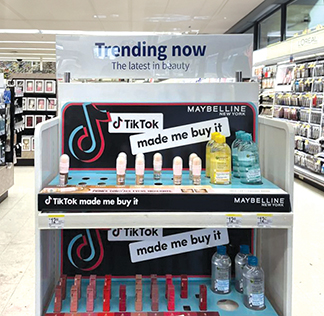In The Age Of ‘SHEconomy,’ Women’s Spending is a Game Changer
She-conomy, which combines the words “she” and “economy,” refers to a phenomenon in which the economy is being fueled by women from all walks of life. The concept was introduced in 2007 when women aroused a keyword in the consumer market, and 16 years later, American women have become more socially active, naturally resulting in more purchasing power. This phenomenon is particularly driven by the younger generation in their 20s and 30s, who, unlike their family-oriented predecessors, are focused on their own consumption and don’t mind spending big on what they want. The rise of sheconomy is also good news for fashion and beauty retailers, who are increasingly trying to capture women’s attention.
In the first half of 2023, ‘sheconomy’ takes the main stage

The movie Barbie, directed by Greta Gerwig, grossed $1.03 billion worldwide in its first 17 days in theaters. Gerwig became the first female director to surpass $1 billion in revenue, and she earns 5 to 15 percent of the license revenue from Barbie merchandise in addition to ticket sales.
Source: Time

In May, Beyoncé performed in Stockholm, Sweden, and tens of thousands of fans from around the world flocked to see her first solo concert in seven years, causing a surge in demand for hotels and restaurants in the area. Sweden’s Consumer Price Index (CPI) rose 9.7% year-on-year in May, according to the Statistics Sweden, with Beyoncé’s performance contributing about 0.2 percentage points of the 9.7% CPI, according to the analysis. Source: Bigstock

The U.S. Federal Reserve released a report showing that every time Taylor Swift performs in a major U.S. city, it changes the economic landscape of that area. The Wall Street Journal (WSJ) has dubbed Swift’s economic impact in revitalizing local economies “Taylornomics”.
Source: Bigstock
Reasons behind the rise of sheconomy and the market shift
More single women in prime working age leading to increase of women’s purchasing power
By 2030, 45% of prime working-age women between the ages of 25 and 44 in the United States will be single,according to a study by investment bank Morgan Stanley. This is the largest percentage increase in recorded history from 41% in 2018. Single women spend more on fashion, food and beverage, and personal care than married women, so retailers are likely to benefit in the future.

In response to #GirlDinner trend, which has garnered nearly 500 million views on TikTok, Papa John’s launched a “Girl Dinner” menu targeted at women who live alone, allowing them to enjoy a quick bite by themselves. The menu contributed to the spike in the number of downloads of the Papa John’s app while generating enthusiasm among women.
Source: Popeyes
The majority of social media influencers are women
In this day and age, there’s no denying that social media is the dominant influence in terms of advertisement and purchase. Data from the Digital Marketing Institute shows that 86% of women use social media to make purchase decisions.
Currently, 76% of influencers on TikTok, the most influential social platform, are women. Other social platforms were not so different in terms of female dominance in number of influencers: 78% on Instagram, 71% on Pinterest, and 69% on YouTube. Generation Z women, born after 1997, are a major force on social media, creating new consumer trends in fashion, makeup, home, career, and more. This trend is reflected on TikTok, where products that go viral with the hashtag #TikTokMadeMeBuyIt often sell like hotcakes in the retail stores.

A cosmetics shelf featuring products that are trending on TikTok. A good example of marketing that leverages the power of social media in brick-and-mortar stores. Some call it a modern version of As Seen on TV.
Source: Georgia Branch Linkedin
Women are more educated; 85% of household consumption driven by women
Earning a bachelor’s degree usually leads to higher earnings, which in turn narrows the gender gap in pay. As of 2019, U.S. women outpaced men in the college-educated labor force, making up more than half (50.7%) of the workforce, and educated women are delaying childbearing and focusing on their careers. Even when married, women are the center of domestic consumption, making 85% of daily spending decisions and 80% of healthcare choices in a household. “Women contribute much more to household income than in the past as well as making more household spending decisions with increased influence,” said Lauren Cassel, a U.S. retail wealth analyst, and this was true whether women were single or married.
Women are launching more startups
Women are starting businesses at a higher rate than ever before, and minority women are outpacing White women. According to a report by A Fast Company, women of color accounted for 89% of new businesses started in 2019.Problems faced by women provide an opportunity for women to address them based on first-hand experience and through the communities around them. Rihanna, who launched Fenty Beauty, is an example of someone who understood that women of color wanted high-quality, multi-toned makeup and succeeded by creating a premium makeup brand tailored to the people of color.
There was also a notable increase in the number of startups founded by middle-income women post-pandemic. Studies have shown that the rate of female entrepreneurship has risen relatively since the passage of the PPP, a follow-up stimulus package focused on helping small businesses, the self-employed, and the underserved communities. In fact, many people realized that they could be their own boss after leaving their jobs during and after COVID-19.
If you don’t understand the “sheconomy”, you will face many challenges in running a beauty supply business which is mainly catering to female consumers. Women have now surpassed men in cultural activities, leisure and social participation.
As women’s purchasing power increases, we expect retailers to benefit from sheconomy by conducting accurate analysis and research on what women want, a long term approach compared to playing marketing “gimmicks”.